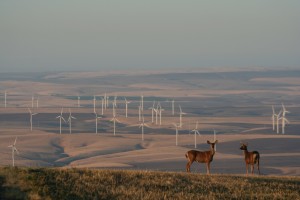Welcome

Mule deer and wind turbines in the Columbia Hills of WA. Credit: Mike Schroeder
The Washington Wildlife Habitat Connectivity Working Group is an open collaborative science-based effort to produce tools and analyses that identify opportunities and priorities to provide habitat connectivity in Washington and surrounding habitats.
The people of Washington treasure our state’s wildlife and natural places. However, as our state becomes increasingly populated and developed, connections across the landscape necessary for wildlife survival are being broken. Wildlife require the ability to move from one habitat to another in search of mates, food, shelter, and new homes as conditions change.
This website aims to make the scientific products easily accessible, and provide links to relevant efforts and information. To date analyses and data layers are currently available at the statewide scale in current condition and in consideration of anticipated impacts of climate change. Finer scale analyses are complete for the Columbia Plateau ecoregion and transboundary Okanagan-Kettles subregion of British Columbia and Washington. Potential exists to address additional ecoregions and continue transboundary work with British Columbia, while we have initiated analysis in coastal Washington to look at connectivity patterns at a finer scale with partners there. Through the Cascadia Partner Forum’s Climate Adaptation Strategy and TerrAdapt spatial tool development, members of our working group are partnering to develop methods to dynamically map habitat connectivity in our region and facilitate prioritization and scenario planning of addressing specific barriers.
Model validation work is critical to informing implementation of habitat connectivity informed by our analyses, and future connectivity assessments. And, beyond the work produced by our working group there are many additional resources to inform and facilitate habitat connectivity efforts from other scientific analyses to relevant policies.
